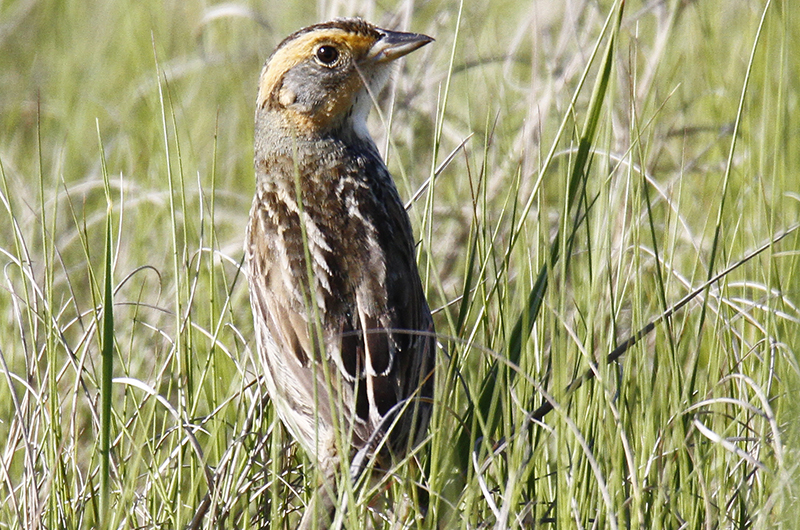All of a sudden, after only a week of hot summer weather, the volume of bird song is greatly diminished. Red-eyed vireos are still singing; they seem to sing all day, even hot ones. Among other loud songsters are cardinals, house finches, Carolina wrens and great crested flycatchers (if you consider their harsh notes a song). Other songsters are much quieter. If they are done nesting there is no need for them to sing to establish and defend territories, and if they still have unfledged youngsters they are probably too tired and busy to sing much.
These quieter mornings are notable. More birds are singing at dawn, but that is so early now that few people are up then to hear them. And if you are consistently up at the time of day, you likely have noticed that there are many fewer birds singing than there were a month ago, or even two weeks ago. This increasing silence makes birds harder to see because they are not advertising their presence with song. Bird song will continue to diminish as the summer season continues.
Bird Sightings
Jeff Bernier heard a lot of frantic crows making quite a ruckus at Island Cohousing on July 9. The source of their discomfort was a common raven, which they were trying to chase away. His photographs are diagnostic, showing the massive head and beak of the raven. He comments that the raven’s voice is also much louder and on a completely different pitch. The noisy crows finally succeeded and the raven flew off to the east. Maybe all the way to the Oklahoma section of Vineyard Haven – it is not far as the raven flies – where Betty Burton has been frequently seeing one visiting her yard.
Warren Woessner adds another shorebird to the southbound migration list — he spotted a flock of 8 short-billed dowitchers on the Norton Point Beach shoreline of Mattakesett Bay on July 8. He also spotted saltmarsh sparrows in salt marshes at both Norton Point Beach and Sengekontacket Pond on July 2. My July 7 bird tour highlights also included several sharp-tailed sparrows that landed and disappeared into the middle of the same Norton Point Beach salt marshes. This is a typical behavior for this species. We also spotted five young plovers, four pairs of willets, and about 300 common terns with a few roseate terns mixed in.
Dave Dawson found a ruby-throated hummingbird in his yard on July 9; she was sitting on her tiny nest constructed from lichens.
Tim Leland reports an immature black-crowned night-heron and a black skimmer foraging on Poucha Pond on July 8. Michael Ditchfield also reports a skimmer at Sengekontacket Pond on July 8. And Steven Carey spotted a black skimmer at Eastville Point Beach, which is likely a new location for this species.
Sharon Simonin reports five green herons, oystercatchers and least terns, all on the evening of July 7 at the Lagoon. Debra Luce also spotted a green heron at Farm Pond.
And speaking of leasties, there are quite a few chicks running around in the small colony nesting on Eastville Point Beach – and of course in the other colonies as well.
The July 5 Felix Neck early birders group featured sightings of green heron, turkey vultures, fledgling tree swallows and a belted kingfisher. Steve Allen also birded Felix Neck on July 7 and spotted both a great egret and hen mallard with one chick. Angela Henderson also spotted a great egret perched high up in a tree on Chappy that same day.
Steven Carey was birding quite a bit on July 4 and 5, and reports the following highlights: Carolina wrens are nesting in his yard, a common loon was in Katama Bay, and at Cedar Tree Neck he spotted 19 species including redstart, red-eyed vireo, common yellowthroat, yellow warbler, barn swallow, bank swallow, great egret, cedar waxwings and, last but not least, an immature laughing gull.
Doreen McCabe spotted a scarlet tanager at Blackwater Pond Preserve on July 3. And Catherine Deese had one bathing in a bird bath in her yard.
Samantha Hartley had a female Baltimore oriole visit her feeder on July 8, as did Sarah Carr, Susan Shea, Steve Allen and Ebba Hierta. Many others are also around — this species seems especially abundant this year.
Gus and Debbie Ben David recently made a pilgrimage to Priester’s Pond with grandchildren Noah and Natalina. While they were there to fish for the abundant yellow perch, bluegills and brown bullhead catfish, they also spotted two broods of wood ducks, a species that can be found annually on that pond.
Eastern towhees are also plentiful. Males and females are easy to identify, even without their former name of rufous-sided towhee which more accurately described their appearance. But beware the juvenile towhees, which look nothing like either parent; the juvies can easily be mistaken for large brown streaked sparrows.
Two leucistic downy woodpeckers have been spotted in the past two weeks. Walt Looney spotted one as reported in last week’s column, and on July 8, another one was observed by Stuart Santos at Sheriff’s Meadow Sanctuary in Edgartown. It is unlikely that these are the same individuals.
Greater shearwaters experience two summers every year since they breed on islands in the South Atlantic during the southern hemisphere’s summer and then they migrate to the North Atlantic for our summer. Such long-distance migrations are stressful, and unfortunately Pete Gilmore found a dead greater shearwater on Lambert’s Cove Beach on July 7.
A number of birders have reported families of turkey chicks in their yards or along the roadsides. Paul Bailey also adds three baby skunks to the turkeys and assorted other birds in his yard.
The breeding season is still in full swing even though southbound migrant have started to show up. Please report all your sightings to birds@mvgazette.com.
Robert Culbert leads Saturday morning Guided Birding Tours and is an ecological consultant living in Vineyard Haven.








Comments
Comment policy »